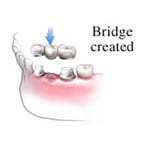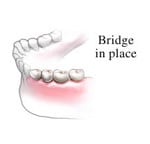

A bridge is a dental appliance that replaces one or more natural missing teeth, thereby “bridging” the space between two teeth. A fixed bridge is cemented into place next to “abutment” teeth – the surrounding teeth on either side of the space, or “span.” Unlike removable partial dentures, a fixed bridge cannot be taken out of the mouth by the patient.
If you are missing any teeth and are committed to maintaining good oral hygiene practices, you may be a good candidate for a bridge. A bridge is the most natural choice to fill the space in your mouth left by missing teeth. This space can cause the surrounding teeth to drift out of position and can cause teeth and gums to become more susceptible to tooth decay and gum disease that can cause further tooth loss.
Fixed bridges not only correct an altered bite, improve your chewing ability and speech, but they also safeguard your appearance by preventing the collapse of your facial features that can cause premature wrinkles and age lines.
Besides traditional bridges, another popular design is the resin bonded or “Maryland” bridge, primarily used for the front teeth. This is usually the most economical choice when the abutment teeth are healthy and don`t contain large fillings. The pontic is fused to metal bands that can be bonded to the abutment teeth with resin cement and hidden from view, reducing the amount of preparation on the adjacent teeth.
A cantilever bridge may be used if there are teeth on only one side of the span. This involves anchoring the pontic to one side over one or more natural, adjacent teeth. If there are no adjacent teeth to act as anchors, your dentist may recommend an implant – a metal post that is surgically imbedded into the bone and capped with a crown as an abutment. In some cases where the span is large, your dentist may recommend a removable partial denture or even an implant-supported prosthesis.
For a traditional fixed bridge, the first appointment consists of the dentist reducing the adjacent abutment teeth that will act as anchors. Impressions are made, from which a metal framework, including the pontic, is created. By the second appointment, the final bridge is fitted over the teeth.
The total treatment time is usually between two and four weeks, depending on the type of bridge. However, because it is often difficult to match the natural shade of your teeth, the treatment time may be longer.
With a bridge, it is more important than ever to brush, floss and see your dentist regularly. If you do not control the buildup of food debris and plaque – the sticky film of bacteria formed from acids in foods – your teeth and gums can become infected, requiring further treatment and resulting in possible loss of the bridge. Your dentist may also recommend using floss threaders that help remove bacteria from hard to reach spaces between the bridge and adjacent teeth and gums.





